You would think that with the weather lately, I’d never consider playing a game called “FIRE ‘N ICE!” Am I right? HA HA! Some topical weather humour there for you!! Well, in all seriousness Fire ‘N Ice has long been one of my most wanted games. Recently I had the opportunity to get the Famicom version as part of a bundle, so I jumped on it. And so I finally had some version of Fire ‘N Ice in my possession.
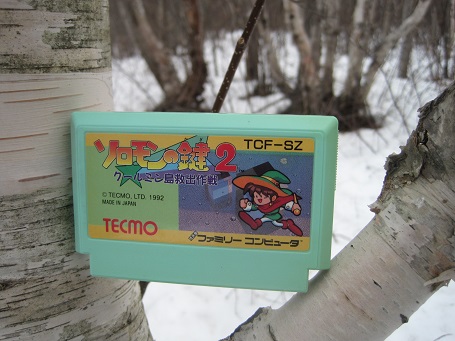
The Famicom version of Fire ‘N Ice is known as Solomon no Kagi 2 – it is in fact in the same series as Solomon’s Key. That game had you in control of the wizard, Dana, obtaining keys to travel through a series of rooms. It was unforgiving partially due to its length and lack of a save or password system. It eventually spawned a prequel, Solomon no Kagi 2, which was completely different.
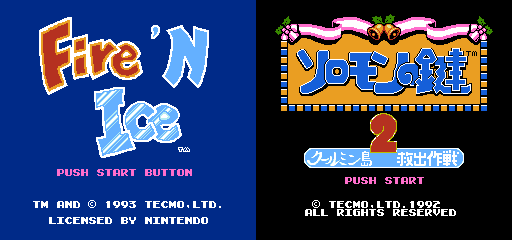
Where Solomon’s Key was difficult due to the stringency of its gameplay and its continue system, Fire ‘N Ice trades this in for really well constructed puzzles. The presence of three save slots is another huge boon, a welcome addition over Solomon’s Key. You are also allowed to play most of the worlds in the order of your choosing. This allows you to put aside a stumping puzzle for a while, and concentrate on other levels for a while – an interesting way to keep the player stimulated without immediately frustrating them.

Fire ‘N Ice also stars the wizard, Dana, who is attempting to save Coolmint Island from being melted by the nefarious Druidle. Although Dana is a beginner, his magic can manipulate ice and luckily enough – that can extinguish the flames Druidle let loose all over the island! How convenient.
Your manipulation of ice is limited, however. You can generate a block of ice in an empty space to the lower left or lower right of your character. If that space is filled with ice already, then that ice will be destroyed. Ice blocks that are not attached to anything can be kicked and are influenced by gravity. This means that you must generate rows of ice, then separate singular blocks to move around – with the ultimate intent of extinguishing a flame with it.

It’s not always so simple, however. You have to manipulate ice in such a way that you don’t block yourself off later. For instance, if the ice you generate to reach the top of the screen blocks your path when you later land on the bottom level and have to return to the top. There are other cases where you must selectively destroy blocks so the layers above you fall in a certain way so as to accommodate Dana’s movement later. Or perhaps you want to drop the middle of a 1×3 rectangle of ice on a flame so it splits into two 1×1 squares that you can use to put out the fire on a lower level? There are a myriad of situations and many of the stages require you to think in new ways.
It’s not just the ice either. As the Worlds progress in number, you get different elements like pipes to transport Dana, burners that melt ice and can’t be extinguished, and heavy black ice that cannot be melted. It’s a great progression of elements. And so each move you make will eventually become very crucial. A wrong move can disrupt any number of elements.
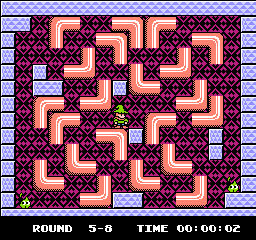

But it’s not always so fatal. At any time you can restart the stage, leave the stage, or if you are playing the Famicom version you can even undo your moves (seemingly back to your first move). So if you mess up, it’s not a big deal. You can either retry the whole works or just the last section. This helps with player fatigue, but it doesn’t make the puzzles any easier. You still have to find the solution. This system just cuts you a break if you’ve spent a minute rearranging ice and accidentally walked off a cliff.
In all there are 100 Stages across 10 Worlds, with a boss fight as the tenth stage of every World. Unlike most of the Stages, these seem to be required to tackle in sequence (for example, you can‘t fight a boss until you defeat the previous World’s champion). The boss fights featuring moving elements – either moving enemies or a moving stage. Moving enemies means you have to time your ice correctly, sometimes even requiring you to sneak by them to get a better vantage. When the stage moves, the enemies are stationary. Every couple of seconds the whole stage shifts down bring you closer to the fire at the bottom. The stage scrolls, so if you miss a fire you might have a chance at the second pass. You need to knock the flames out while not blocking yourself from moving upwards later when the stage scrolls around to that point. Where most Stages are about logic, Boss stages are about both planning and reflex.
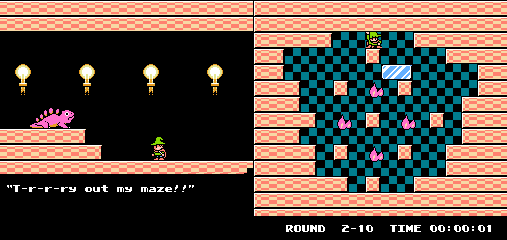
Fire ‘N Ice is the kind of game that has to be played to be appreciated, you have to get a feeling for the controls. It’s logical and tight, so any fan of the likes of Adventures of Lolo or Kickle Cubicle or Solomon’s Key will like it. It’s also a really sizeable game that allows you to approach it at your own liking. That’s tremendous! And if you manage to beat this game? You will be given a code. This code activates the sound test and 50 additional levels. That’s a huge boost in longevity. And if that’s not enough, it has an Editor.
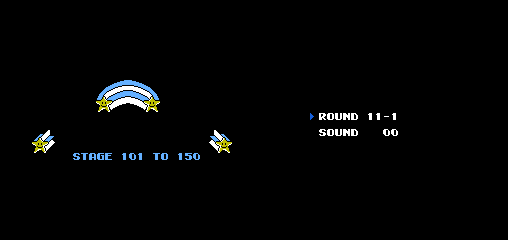
Fire ‘N Ice is a cute game. Dana is well animated and every World has its own special Flame enemy, each with its own level of character. It’s colourful and it’s clean. The sound effects really work with what you’re seeing, and the music is really catchy. Style and substance. This game is just quality.
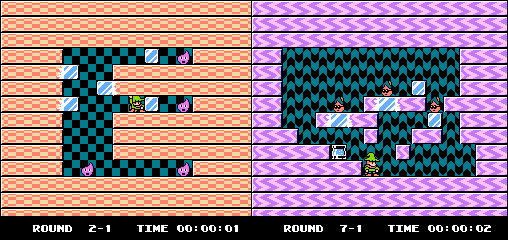
I gush because this is my jam. These NES puzzlers, they just resonate with me. Fire ‘N Ice has always had this allure to me because it was obscure and quirky and colourful and fun. I was not disappointed. I crushed a lot of levels, but I would also hit these walls. I like a puzzle game where you can leave it and think of the solution while you’re doing something else. Like you’re in the shower and all of a sudden you’re like “AH HA! I’ll complete you now World 6!” That’s the kind of game Fire ‘N Ice turned out to be. It’s a puzzling game, but it makes sense. And the techniques you learn come in handy later. And yes you can get stumped. But then you look at that room one more time and it just clicks. You can see three moves ahead.
Is it worth tracking down a copy of this game? If you’re passionate about the genre – absolutely. It’s not a cheap game or even a common one. The Famicom version is more affordable, but it’s still a bit high. I was super lucky with my purchase, it was one hell of a score. I’d sit on this one, wait until the moment is right and bite. It’s an excellent game, but it definitely helps to be an enthusiast if you plan to track it down.

Congrats on finally getting this and finishing it!
Visually it’s a nice looking game, but as you already know these puzzle type games aren’t what I seek out, but I may try going through this if I’m bored enough and have nothing else to do.